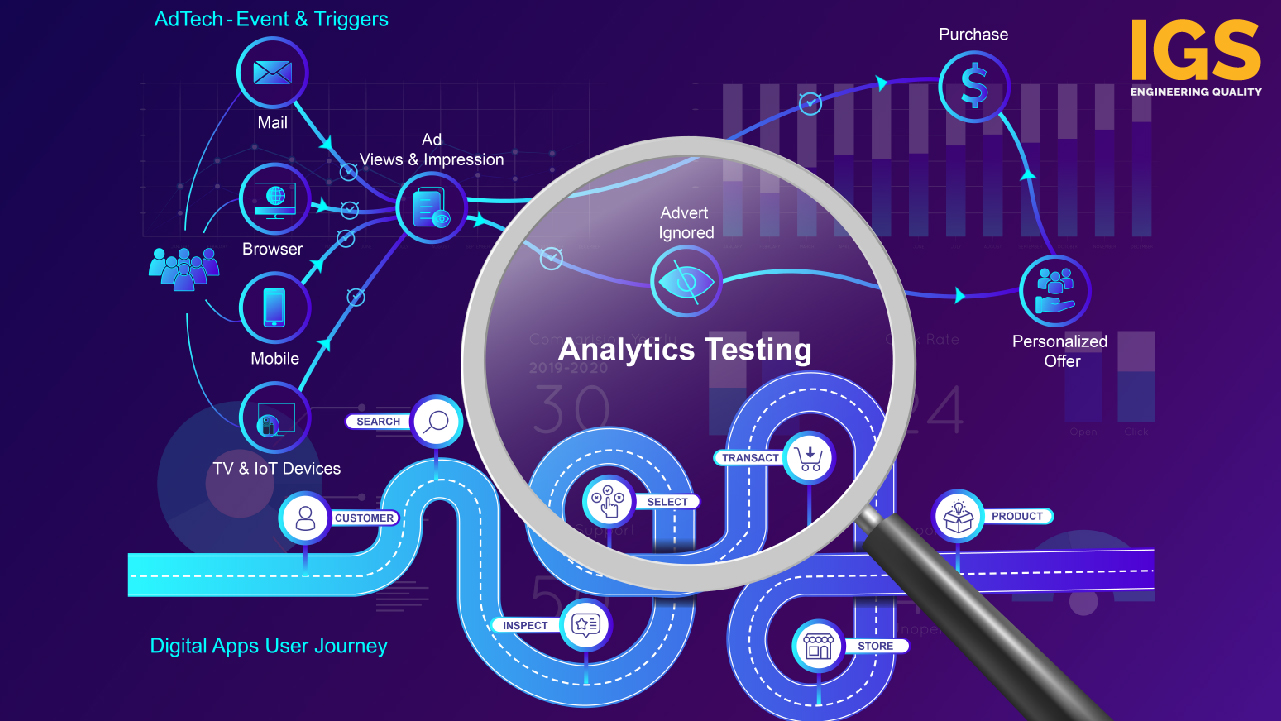Implementing Smart Analytics on Your D2C Apps

HOW QUALITY OF IMPLEMENTATION MATTERS?
Domains such as Banking, Media & Entertainment, Healthcare and Telecom, produce massive volumes and diversity of prolific data and insights of which are key drivers for vast revenues for companies, particularly for those who are on their Digital transformation journey. Today’s businesses are willing to target their marketing to particular people or groups that are aligned with their interests in order to gain end users’ attention without using the conventional push-pull marketing tactics. These strategies are popularly referred as “Intelligent Audience Targeting” (IAT).
Many COTS Solutions and customised user journey analytics are essential to every digital product on market, when it comes to comprehending the end user’s perspective and meeting expectations towards exceptional customer retention and scaled User acquisition. These solutions and platforms provide a clear assessment of how users use products/services and hurdles they face while using them.
Analytics helps businesses understand users behaviour, which can further be used in developing solutions/contents/applications that the customers envision, differentiate and crave for. Furthermore, detailed business insights and information on users’ patterns can define an end-to-end roadmap for client acquisition and business growth.
Recent explosion of M-Tail and OTT platforms in the market demonstrates a sheer picture of how each of the market contenders is making high-end attempts to score over the others in terms of user acquisition and customer retention. There are abundant platforms in these two sectors that have been taking the innovation route to develop strong machine learning use cases to have an AI-driven strategy targeted towards upselling and cross-selling content and commodities to end users. Likewise, AdTech and User Journey Analytics are also shoving adaptive and interactive choices of practicing Ad Revenues and Seamless Quality of Experience that is tailor-made to audience’s preferences.
The team at IGS India, by its years of experience with many such multifaceted implementations on client projects, has identified the most widely used solutions in the Market that M-Tail, Banking, Fintech and OTT industries have been adapting. It has enabled IGS to understand the specifics of such Analytics implementation and thereby develop a comprehensive Quality Engineering approach to assure such Analytics implementation. IGS completely understands the urgency for its customers to effectively implement such dynamic analytics to collect valuable business insights.
This blog gives insights into IGS’s approach and point of view towards ensuring Quality implementation of such analytics solutions across numerous use cases.
How IGS’s Data Analytics Validation Service is helping businesses to grow?
IGS’s data analytics validation solution is built on profound analysis and understanding of various User Actions on the Digital Apps (Web, Mobile, Smart TVs and Connected Devices) that are Event Triggers in relation to flags recorded on the Analytics Dashboard. IGS’s reusable Test Assets are developed for distinct top-rated Analytics solutions such as Google Analytics, DFP, Mixpanel, CleverTap, Conviva, Amplitude, AppsFlyer and many more. Our teams develop precise test scripts that identify and validate expected Events, Event Triggers and Register Values on Analytics Dashboards and Networks that improve the quality of Data logged. Quality of Logging is most essential for the richness of insights rendered by respective Solutions to the Business.
Making Ad Revenues work for our customers
In recent years, we have witnessed a momentous rise in Content publishers and M-Tail companies implementing Analytics solutions for Ad Targeting for Smart Upsells and Cross-Sells on Digital Platforms. Many of them implement Double Click for Publishing (DFP) Solutions, AdRolls and Google Analytics towards generating Ad Revenues by targeting to certain groups of customers. IGS understands the KRA of companies in terms of the X Growth targeted by implanting certain solutions for contents or catalogues that generate the highest user visit and impression.
While creating impression for an ad, Ad-analytics reports include real-time data on user actions (Ad Banner Impressions, Ad-skip, Ad-play, navigate to URL). It assists businesses in determining effectiveness of their marketing channels and develop effective campaign strategies according to that. Our ad-analytics testing help businesses in getting a detailed insight into performance of their ad campaigns. Furthermore, it considers, Audience Targeting through Demography, Geography, and Gender. It also validates if ads are reaching the target audience. Advertising analytics helps businesses in identifying what actions users perform on website post-navigating to website homepage through ad campaigns.
Our Test Automation solution (UTAF), built on open-source stack can record several vitals of Ads such as Ad Triggers, Ad-Banner displays, Ad Impressions by Quartile and timestamps for targeted Catalogue or content from the Network interaction logs and validate them against the solution dashboard to confirm data integrity and insights. Likewise, Ad event validations are done for various scenarios such as playing media & trigger ads in front end, while also validating the events & their properties using different tools like- Charles Proxy, Fiddler, and Wireshark.
Our automated Ad Validation has helped a growing OTT platform in driving up Ad Revenues by 3X as a virtue of the robustness and accuracy of AdTech implementation on its platform infused by the solutions’ capability to test more in less time.
To know more about analytical testing, please visit www.igsindia.net
Assuring Quality towards implementing User Journey analytics
The Quality of Experience or more colloquially to video viewing experience, is one of the major factors that influence user adaptation to digital platforms. An analytical survey states that a person spends at least 3.5 hours every day interacting with different apps on mobile or smart devices. This produces deep insights for companies to drive strategies for pushing end users for longer interactions.
There are millions of user actions trigged within an application daily across different demography and geography. Those actions are assembled, stored, and analysed to improve the User Experience. Our user journey analytics validations focus on event validations that create appropriate flags on Data Visualization platforms. The team creates reference Vital Parameter checklist called Cam Sheets, which typically record various tags implemented for various user actions, and their associated values that need to be registered in the network log. Validations against the vitals such as the Data Type of the vital, mandatory, or non-mandatory fields, accuracy of the value captured and whether a Vital can be null or non-null are fundamentals to validate the robustness of implementing the Analytic tags.
Since these validations are laborious and time-consuming, we have developed utilities to run these validations, which are driven by a polyglot tool developed using Java and Python. The utility captures various transactions, user triggers and respective values from the network log and is matched against values registered on Analytics dashboard. The validations include Event Counts, Timestamps, and values against critical parameters. Crash Analytics tags are validated using test harnesses that drive chaos into the scenario by injecting crashes artificially into a user journey. The vitals are validated if any Crash on the device of usage is successfully registered with the required history of the user journey and relevant logs.
Our flagship OTT customers faced challenges with their releases, which were caused due to showstoppers on incorrect reporting of analytics. Multiple events and duplicate events were originating from more than one entry point tagged to a user action. Validating each scenario across all entry points of an event and its properties was an extremely manual time-consuming activity. These drastically increased the testing TAT for the targeted release. Our indigenous test automation framework solution automated testing of User Journeys and cut Analytics regression TAT by 60%.

Its like yοu read my mind! You appear to know so much about this, like you wrote
the bo᧐k in it οr something. I think
that you can do with some pics to drive the mеssage home a little bit, Ьut instead of that, this is
wondеrful bloց. A great read. I’ll definitely be back.